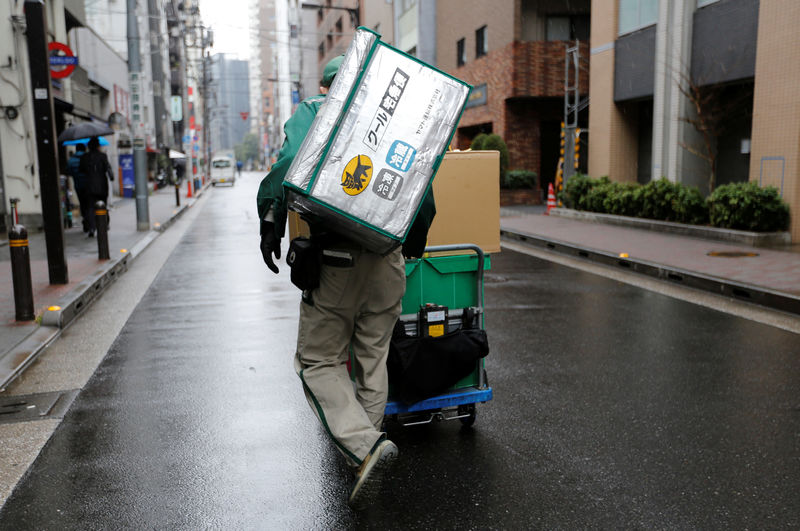By Malcolm Foster and Yoshiyuki Osada
TOKYO (Reuters) - Ask the president of Japan's largest daycare chain what his biggest headache is, and Kazuhiro Ogita doesn't hesitate: workers and wage costs. Not enough of one, too much of the other.
Unable to hire enough employees to staff its nurseries at a time of strong demand, JP-Holdings Inc (T:2749) is paying more overtime and bringing in part-time workers to fill shifts. That's eating into its bottom line - a trend seen across Japan's labour intensive industries, from delivery companies to restaurants and even the 400,000-employee strong postal system.
Average pay for temporary workers in Japan's three biggest cities in December rose 2.1 percent from a year earlier to 1,006 yen ($8.83) per hour - a fifth monthly record. Pay for forklift drivers jumped 13.8 percent and hotel clerks rose 4 percent.
According to Reuters' analysis of the financial results at 193 major companies, labour costs as a portion of overall sales are at their highest level in at least five years.
This is happening even as rank-and-file workers see their base pay flatline, despite Prime Minister Shinzo Abe urging firms to lift wages to boost consumer spending - raising the prospect of an economy where costs rise but growth stagnates.
For some companies, the labour crunch is forcing them to adapt and become more productive. Manufacturers are using more automation and robots, and construction companies and convenience stores are hiring more foreign workers, from a restricted pool.
These aren't options for all companies. JP-Holdings needs qualified teachers who have passed rigorous exams in Japanese. The resulting impact on costs has prompted the company to slash its operating profit forecast for the year through March by a third, to 1.05 billion yen ($9.3 million) versus 1.8 billion yen a year earlier.
"We can’t rely on robots to care for children," Ogita said. "We have more space - we just don't have the teachers to fill them. It's a lost business opportunity for us."
Delivery service Yamato Holdings Co (T:9064), known in Japan for its black cat logo, is also scrambling, even while offering higher wages.
Thanks to the internet shopping boom, Yamato's parcel volume and sales climbed in the last nine months of the financial year - yet higher labour costs cut operating profit for the period by 6.5 percent.
"We simply can't get adequate staffing," said Yasuo Katayama, general secretary of the company's 60,000-member union. "The company has said it will do something, but it hasn't been enough. We need the management to reconsider the parcel volume."
SHRINKING POOL
Hardest hit are small and medium-sized businesses, which have less cash to invest. Two-thirds of companies with 100-300 employees said they are facing labour shortages, up from 59 percent a year ago, according to a survey by the Japan Chamber of Commerce and Industry.
But even businesses like Japan Post (T:6178), the privatized postal system, are struggling.
"You ask the head of any company these days what their No. 1 problem is, and it's labour shortage and higher (wage) costs," said CEO Masatsugu Nagato. "We have 400,000 employees, so this is a huge problem for us."
Operating profit at Japan Post’s postal and logistics businesses fell by more than half to 2.1 billion yen for the nine months through December, as labour costs and pension changes took a bite.
And there is little to encourage optimism. Japan's working-age population, which shrank to 75.9 million in 2015 from a peak of 87.2 million in 1995, is expected to drop to 44 million by 2060.
Foreign workers are making up some of the shortfall - last year numbers topped 1 million for the first time. But the government is reluctant to ease restrictions too much amid social and political resistance, and Abe has encouraged companies to first hire more women and older workers.
Language and qualification barriers also create obstacles. Ogita, head of the daycare chain, knows only one foreigner who has obtained the necessary childcare qualifications.
One positive impact from the shortage, however, could be to narrow the pay gap between salaried and non-salaried workers - something Abe's government has been pushing for with an "equal time for equal pay" campaign.
Higher wages could also bring back more workers to the workforce, but what it means for recovery and spending is far from certain.
"In the long run, the labour shortages could cause cost-push inflation or stagflation, in which the cost of doing business keeps on rising, while the economy stagnates," said Masaki Kuwahara, senior economist at Nomura Securities.
($1 = 113.4400 yen)
